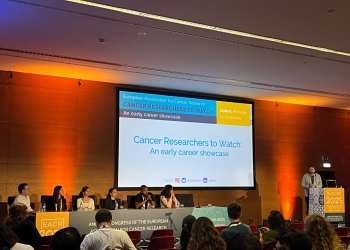The EACR’s Top 10 Cancer Research Publications is a regular summary of the most interesting and impactful recent papers in cancer research. It is curated by the Board of the European Association for Cancer Research (EACR).
The list below appears in no particular order, and the summary information has been provided to us by the authors.
Use the dropdown menu or ‘Previous’ and ‘Next’ buttons to navigate the list.
Papers 7-9 are all connected
“These three papers identify a new vulnerability in human cancers based on a novel synthetic lethal interaction.” Alberto Bardelli, EACR President
E.M. Chan, T. Shibue et al., Nature (2019)
Brief summary of the findings
Defects in DNA mismatch repair promote a hypermutable state called microsatellite instability (MSI). MSI contributes to the pathogenesis of several malignancies, especially subsets of colon, stomach, ovary and uterus cancers, collectively accounting for as many as 500,000 new cancer diagnoses per year worldwide. We hypothesized that the impaired DNA repair and ensuing accumulation of genomic aberrations in MSI may create specific vulnerabilities in these tumors, especially in other proteins related to DNA repair and stability. Therefore, we systematically analyzed genome-wide loss-of-function screens using CRISPR-mediated gene knockout and RNAi-mediated gene silencing across hundreds of cancer cell lines to identify genes selectively essential for the survival and proliferation of MSI cancers. We found that the WRN helicase is essential for MSI cancer models but dispensable in cancers without MSI. Depletion of WRN causes DNA double-strand breaks, ultimately inducing cell death and cell cycle arrest selectively in MSI cancer models. Furthermore, we established that the helicase enzymatic function of WRN is specifically essential in MSI cancers. These observations uncover a synthetic lethal relationship between MSI and loss of WRN and nominate WRN as a promising therapeutic target in MSI cancers.
Future impacts of the findings
Many MSI cancers respond favorably to immune checkpoint blockade. However, there remains a clear need for new therapies due to both common intrinsic and acquired resistance to these immune agents as well as toxicity that limits the use of immunotherapy in many patients. By demonstrating that WRN is a synthetic lethal vulnerability in MSI cancers, essential in MSI cells but dispensable in non-MSI cells, this report suggests that WRN inhibition could both serve as a highly effective and well-tolerated therapy against MSI cancers. These results strongly support the development of new WRN inhibitors.









